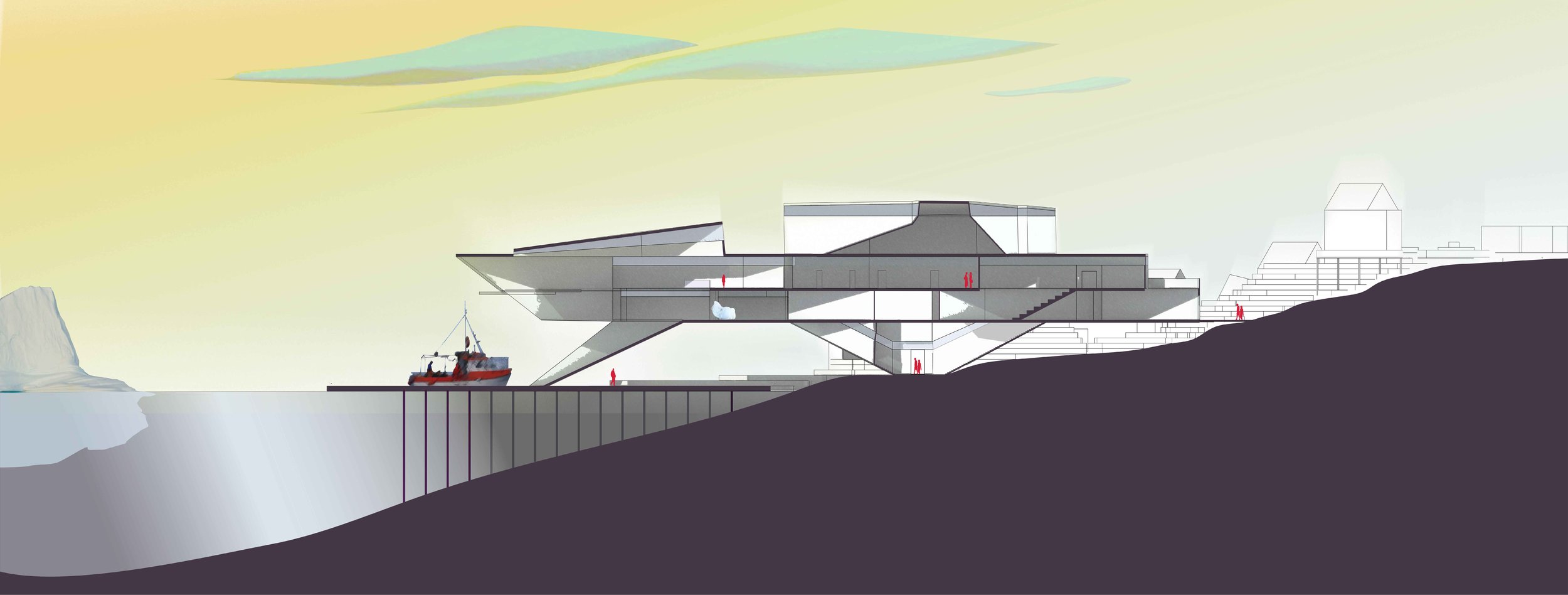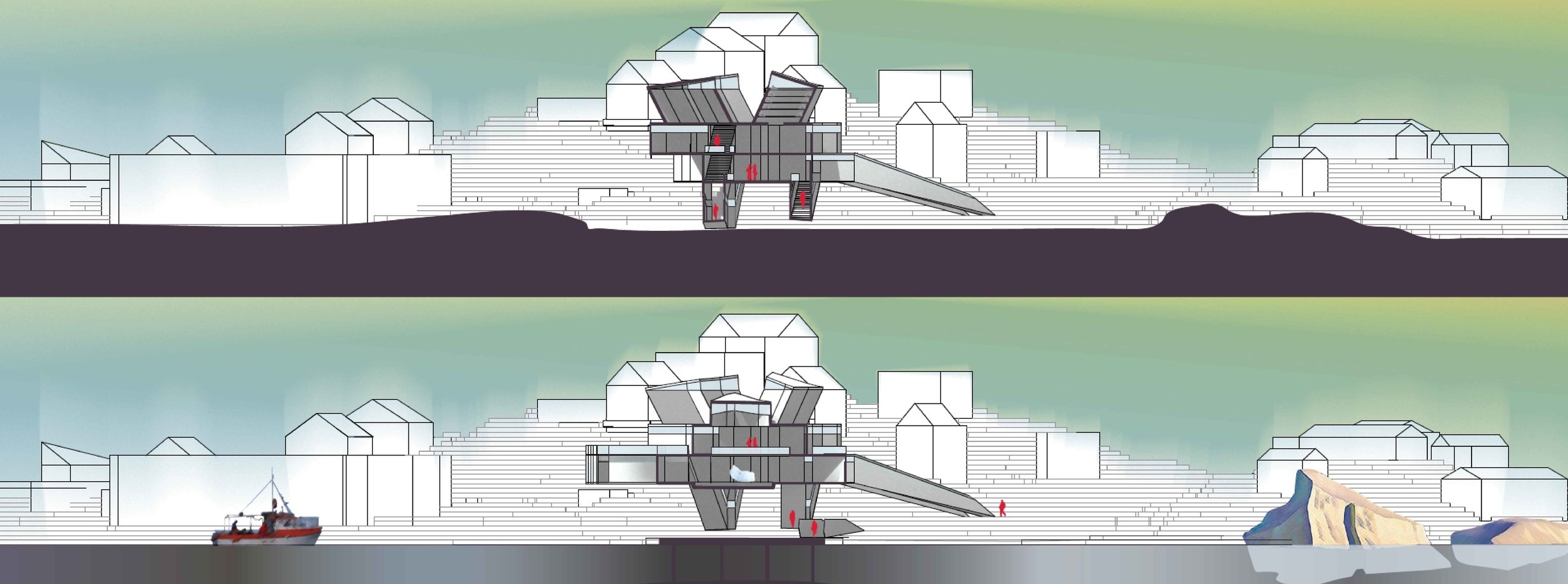





















K A T I L V I K
-A SPACE OF GATHERING-
**Click HERE for thesis research pages.**
THESIS STATEMENT. YASMEEN FARRAJ & JACOB SOLOSKI. SPRING 2017.
Rich in terms of its cultural and historical prevalence within Greenland, the small island of Uummannaq exists as an important link between past traditions and an evolving way of life. Surrounded by a landscape of rugged terrain, ice, glaciers, and icebergs, Uummannaq sits at the center of an ever changing environment. The vanishing of the ice affects the inner workings of the island on three different scales of time, namely, Human, Glacial, and Scientific time.
GLACIAL TIME [VISUAL / YEARS]
Glacial time is seen in the gradual retreat of the ice. Its retreat is mostly ghostly and unseen periodically fading and disappearing. The loss of the ice is irreversible, but it can still be preserved and respected as an important entity and direct connector to the shifting global atmosphere. It is a deteriorating monolith becoming increasingly fragmented, shifted, and thinned over time. Its disappearance can be felt through the shift in traditions as well as the personality of the island. Thinning ice has caused a shift in the way traditional hunting practices are carried out, as a result, modern technology has appeared as a new substitute. Without scientific time, glacial time is analytically incalculable.
SCIENTIFIC TIME [NUMERICAL / INFINITESIMAL]
Scientific time is seen in the processing and monitoring of the ice sheet. The scientists are the ones who are able to calculate and determine the life cycle of the ice, its age, its future, and predict the time of its death. Scientific time, human time, and glacial time can fuse together to create the formula for a new system for the island. The scientists are the villagers, the preservers, the teachers, and a part of the culture of the future modern generation of Uummannaq. Local knowledge of the power of the ice will grow with time on an analytical level in tandem with the cultural reverence for its spiritual importance to the island.
HUMAN TIME [PHYSICAL / PRESENT]
Human time is seen in the shifting personality of the island, particularly in the expression of the architectural elements. Above ground piping systems, and stilted architecture lightly touch down on the rugged landscape creating a web like system of draped linear elements. Glacial time influences human time in that the vanishing of the ice creates shifts in programmatic relationships. New tools, new infrastructure (rising seas=rising structures), and new practices. Depopulation and youth migration away from the island are synonymous with the disappearance of the ice. These two vanishing elemental bodies alter the life of the island by creating a warp in the natural flow of human and glacial time. Both are physical markers in the measurement of the lifespan of the island.
SCIENCE & CULTURE
The science of the ice in combination with the Uummannaq reverence for nature in terms of its spiritual qualities creates the potential for a space of gathering that promotes knowledge, learning, and a deeper interaction with the analytical and complex properties of the ice.This building serves as a fusing space for Uummannaq scientists and the community to see the ice from a new perspective in an analytical fashion and preserve the glaciers importance through scientific monitoring and inquiry. It is not a space of mourning for the ice’s disappearance, rather it is a space of celebration of its existence and a promotion for its respect as a fragile yet important entity surrounding the lives of the people of Uummannaq. It is a climatic research center that introduces science and technology to the island while connecting with the younger generation that struggle to find a balance between traditional values and the modern life.Glacial time, human time, and scientific time can come together to influence the future of Uummannaq which depends on the education and interest of the next generation in the purpose of the ice.It is a human as well a an intellectual space of gathering.
FORM
Apart of the island, it rises and falls touching down on the landscape while maintaining a light connection to the ground. It is linked, stacked, and layered, but a free form both fused, frayed, and multi directional in its behavior in accordance to the ground. Perforations follow the bends of the planes creating a series of linear apertures that break the overall mass and divide it highlighting the geometric movement of the bending forms. It is an infrastructure that results from the rule set of glacial behavior as well as the existing architectural elements of the island.

Shown: The red lined areas on the map highlight the focus of the unique features of the island. Its rugged terrain and steep hills are a canvas for a stilted architecture. Homes are supported by wooden posts and exposed stilted pipes are seen throughout the area. These are the veined structures that drape themselves over the landscape.

Shown: Iceberg and Glacier behavior were analyzed to begin the thought process of manipulation of form. Retreat, melt, receding, calving, fracturing, etc. are all verbs that come forth to describe the ice that fades with the passing of time.

Shown: Straws were used as linear elements for the study of manipulation of form representing the retreat and melt of ice. The straws react and distort according to the amount of applied heat. These movements were documented and restricting walls were constructed from intersecting lines extracted from the site plan and surrounding infrastructure.
